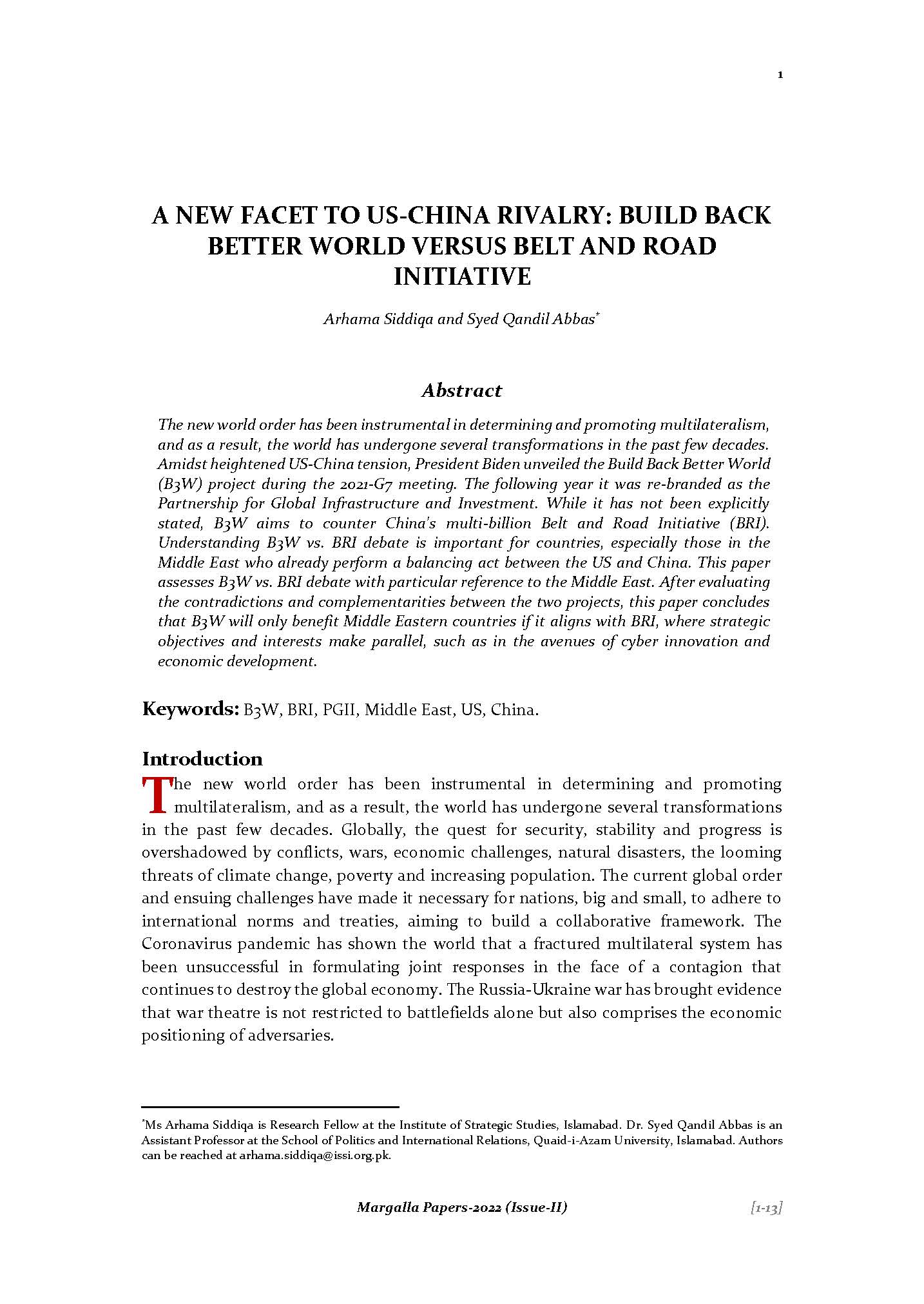A NEW FACET TO US-CHINA RIVALRY: BUILD BACK BETTER WORLD VERSUS BELT AND ROAD INITIATIVE
DOI:
https://doi.org/10.54690/margallapapers.26.2.109Keywords:
B3W, BRI, PGII, Middle East, US, ChinaAbstract
The new world order has been instrumental in determining and promoting multilateralism, and as a result, the world has undergone several transformations in the past few decades. Amidst heightened US-China tension, President Biden unveiled the Build Back Better World (B3W) project during the 2021-G7 meeting. The following year it was re-branded as the Partnership for Global Infrastructure and Investment. While it has not been explicitly stated, B3W aims to counter China's multi-billion Belt and Road Initiative (BRI). Understanding B3W vs. BRI debate is important for countries, especially those in the Middle East who already perform a balancing act between the US and China. This paper assesses B3W vs. BRI debate with particular reference to the Middle East. After evaluating the contradictions and complementarities between the two projects, this paper concludes that B3W will only benefit Middle Eastern countries if it aligns with BRI, where strategic objectives and interests make parallel, such as in the avenues of cyber innovation and economic development.
Bibliography Entry
Siddiqa, Arhama, and Syed Qandil Abbas. 2022. "A New Facet to US-China Rivalry: Build Back Better World versus Belt and Road Initiative." Margalla Papers 26 (2): 1-13.
References
Oinam Ghanashyam Khumancha, “The Great Schism of Geo-politics in 21st Century,” Electronic Journal of Social and Strategic Studies, 2:3, 321-341, DOI:10.47362/EJSSS.2021.2303, December 20, 2021. Available at https://www.ejsss.net.in/uploads/172/13494_pdf.pdf (Accessed November 2022).
M. Zhao, “The Belt and Road Initiative and China-US Strategic Competition,” China International Strategy Rev. (2021). https://doi.org/10.1007/s42533-021-00087-7.
"China’s Massive Belt and Road Initiative,” Council of Foreign Relations, January 28, 2020. Available at https://www.cfr.org/backgrounder/chinas-massive-belt-and-road-initiative (Accessed November 2022).
“Compete, Confront, Cooperate: Climate Summit Test for Biden’s China Watchwords,” The Guardian, April 22, 2021. Available at https://www.theguardian.com/world/2021/apr/22/compete-confront-cooperate-climate-summit-test-for-bidens-china-watchwords (Accessed November 2022).
“Build Back Better World scheme could challenge the BRI," Oxford Analytica, 2021. https://doi.org/10.1108/OXAN-DB262844.
..............................(contd.)

Downloads
Published
How to Cite
Issue
Section
License
Copyright (c) 2023 Arhama Siddiqa ; Syed Qandil Abbas

This work is licensed under a Creative Commons Attribution-NonCommercial 4.0 International License.












